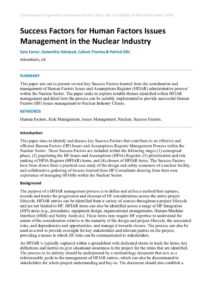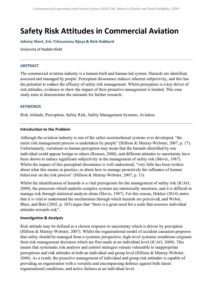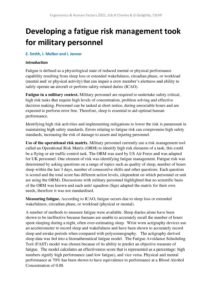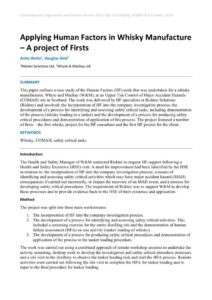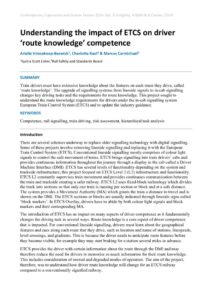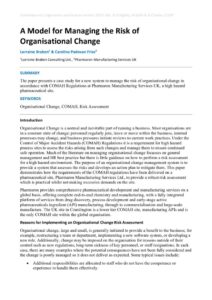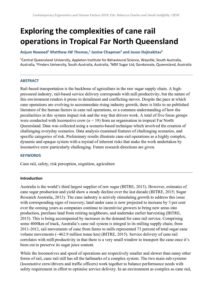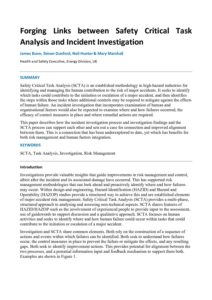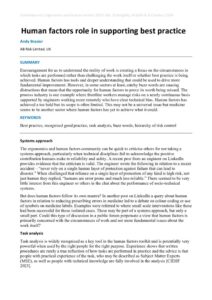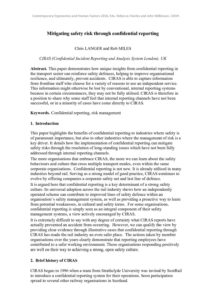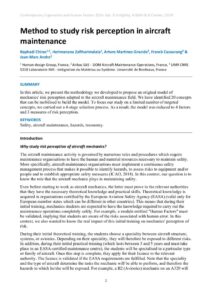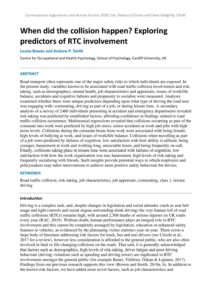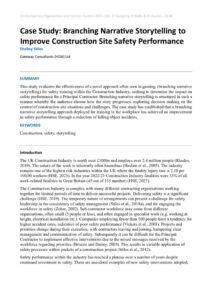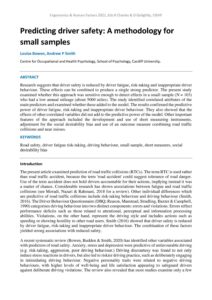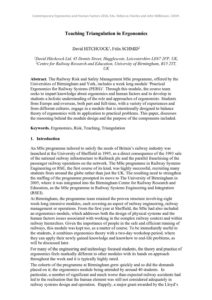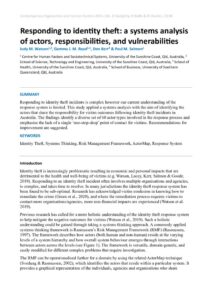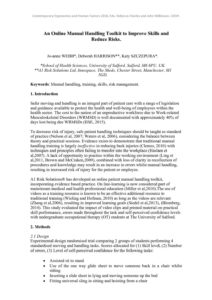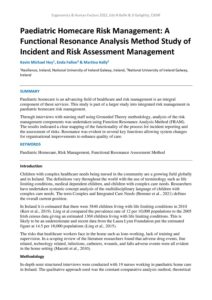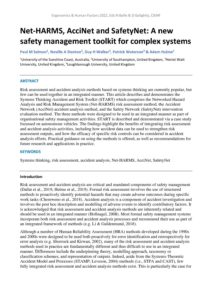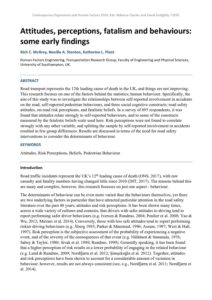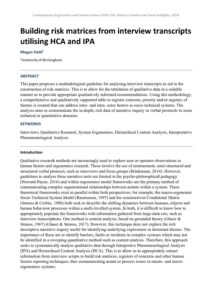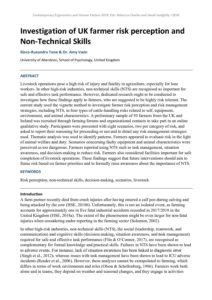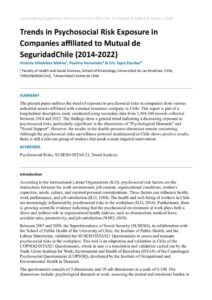Risk assessment
Success Factors for Human Factors Issues Management in the Nuclear Industry
| Document | Author Sam Farrar, Samantha Halstead, Callum Thomas & Patrick Ellis |
| Abstract This paper sets out to present several key Success Factors learned from the coordination and management of Human Factors Issues and Assumptions Register (HFIAR) administrative process’ within the Nuclear Sector. The paper seeks to explore notable themes identified within HFIAR management and detail how the process can be suitably implemented to provide successful Human Factors (HF) Issues management to Nuclear Industry Clients. |
Safety Risk Attitudes in Commercial Aviation
| Document | Author Johnny Short, Eric Tchouamou Njoya & Nick Hubbard |
| Abstract The commercial aviation industry is a human-built and human-led system. Hazards are identified, assessed and managed by people. Perceptual dissonance induces inherent subjectivity, and this has the potential to reduce the efficacy of safety risk management. Whilst perception is a key driver of risk attitudes, evidence to show the impact of their proactive management is limited. This case study aims to demonstrate the rationale for further research. |
Developing a fatigue risk management tool for military personnel
| Document | Author E. Smith, I. Mollan and I. Jenner |
| Abstract |
Applying Human Factors in Whisky Manufacture – A project of Firsts
| Document | Author Anita Weltz, Douglas Dick |
| Abstract This paper outlines a case study of the Human Factors (HF) work that was undertaken for a whisky manufacturer, Whyte and Mackay (W&M), at an Upper Tier Control of Major Accident Hazards (COMAH) site in Scotland. The work was delivered by HF specialists at Risktec Solutions (Risktec) and involved: the incorporation of HF into the company investigation process; the development of a process for identifying and assessing safety critical tasks, including demonstration of the process (whisky loading to a tanker) and the development of a process for producing safety critical procedures and demonstration of application of this process. The project featured a number of firsts – the first whisky project for the HF consultant and the first HF project for the client. |
Understanding the impact of ETCS on driver ‘route knowledge’ competence
| Document | Author Arielle Vriesekoop-Beswick, Charlotte Kaul & Marcus Carmichael |
| Abstract Train drivers must have extensive knowledge about the features on each route they drive, called ‘route knowledge’. The upgrade of signalling systems from lineside signals to in-cab signalling changes key driving tasks and the requirements for route knowledge. This project sought to understand the route knowledge requirements for drivers under the in-cab signalling system European Train Control System (ETCS) and to update the industry guidance. |
A Model for Managing the Risk of Organisational Change
| Document | Author Lorraine Braben & Carolina Padovan Frias |
| Abstract The paper presents a case study for a new system to manage the risk of organisational change in accordance with COMAH Regulations at Pharmaron Manufacturing Services UK, a high hazard pharmaceutical site. |
Exploring the complexities of cane rail operations in Tropical Far North Queensland
| Document | Author Anjum Naweed, Matthew JW Thomas, Janine Chapman and Jason Hajinakitas |
| Abstract Rail-based transportation is the backbone of agriculture in the raw sugar supply chain. A high-pressured industry, rail-based service delivery corresponds with mill productivity, but the nature of this environment renders it prone to derailment and conflicting moves. Despite the pace at which cane operations are evolving to accommodate rising industry growth, there is little to no published literature of the human factors in cane rail operations, or a common understanding of how the peculiarities in this system impact risk and the way that drivers work. A total of five focus groups were conducted with locomotive crew (n = 19) from an organisation in tropical Far North Queensland. Data was collected using a scenario-based technique which involved the creation of challenging everyday scenarios. Data analysis examined features of challenging scenarios, and specific categories of risk. Preliminary results illustrate cane-rail operations as a highly complex, dynamic and opaque system with a myriad of inherent risks that make the work undertaken by locomotive crew particularly challenging. Future research directions are given. |
Forging Links between Safety Critical Task Analysis and Incident Investigation
| Document | Author James Bunn, Simon Dunford, Neil Hunter & Mary Marshall |
| Abstract Safety Critical Task Analysis (SCTA) is an established methodology in high-hazard industries for identifying and managing the human contribution to the risk of major accidents. It seeks to identify which tasks could contribute to the initiation or escalation of a major accident, and then identifies the steps within those tasks where additional controls may be required to mitigate against the effects of human failure. An incident investigation that incorporates examination of human and organisational factors would also be expected to examine where and how failures occurred, the efficacy of control measures in place and where remedial actions are required. This paper describes how the incident investigation process and investigation findings and the SCTA process can support each other and sets out a case for connection and improved alignment between them. This is a connection that has been underexplored to date, yet which has benefits for both risk management and human factors integration. |
The NHS health check for developing HFE competencies
| Document | Author Helen Vosper, Paul Bowie & Sue Hignett |
| Abstract Patient safety is an emergent property of complex sociotechnical healthcare systems. Human Factors and Ergonomics (HFE), with its design-based systems focus, offers frameworks for developing resilient systems, although use in healthcare has been limited to date. Most healthcare educational curricula articulate requirements for students to develop patient safety competencies, but there is scant direction as to how this might be achieved. The authors have produced guidance on embedding HFE in healthcare curricula, but recognise that examples of effective HFE teaching would further support educational practice. This case study outlines a related set of activities based around the NHS Health Check, a population-wide screening programme designed to identify and manage cardiovascular risk. The Health Check represents a cardiovascular risk management system and is amenable to analysis using HFE frameworks. The educational activities described support students in developing a deep awareness of HFE theory, and early development of HFE competencies. The Health Check is a highly relevant professional activity for pharmacy students but would also be relevant to medical and nursing students, as well as healthcare management staff. This case study will form the focus of a discussion that will provide delegates with an opportunity to share experiences of different approaches to HFE education. |
Human factors role in supporting best practice
| Document | Author Andy Brazier |
| Abstract Encouragement for us to understand the reality of work is creating a focus on the circumstances in which tasks are performed rather than challenging the work itself or whether best practice is being achieved. Human factors has tools and deeper understanding that could be used to drive more fundamental improvement. However, in some sectors at least, catchy buzz words are causing distractions that mean that the opportunity for human factors to prove its worth being missed. The process industry is one example where frontline workers manage risks on a nearly continuous basis supported by engineers working more remotely who have clear technical bias. Human factors has achieved a toe hold but its scope is often limited. This may not be a universal issue but medicine seems to be another sector where human factors has yet to achieve what it could. |
Mitigating safety risk through confidential reporting
| Document | Author Chris LANGER and Rob MILES |
| Abstract This paper demonstrates how unique insights from confidential reporting in the transport sector can reinforce safety defences, helping to improve organisational resilience, and ultimately, prevent accidents. CIRAS is able to capture information from frontline staff who choose for a variety of reasons to use an independent service. This information might otherwise be lost by conventional, internal reporting systems because in certain circumstances, they may not be fully utilised. CIRAS is therefore in a position to share why some staff feel that internal reporting channels have not been successful, or in a minority of cases have come directly to CIRAS. |
Method to study risk perception in aircraft maintenance
| Document | Author Raphaël Chirac, Herimanana Zafiharimalala, Arturo Martinez-Gracida, Franck Cazaurang & Jean-Marc Andre |
| Abstract In this article, we present the methodology we developed to propose an original model of mechanics' risk perception adapted to the aircraft maintenance field. We have identified 20 concepts that can be mobilised to build the model. To focus our study on a limited number of targeted concepts, we carried out a 4-stage selection process. As a result, the model was reduced to 4 factors and 3 measures of risk perception. |
When did the collision happen? Exploring predictors of RTC involvement
| Document | Author Louise Bowen and Andrew P. Smith |
| Abstract Road transport often represents one of the major safety risks to which individuals are exposed. In the present study, variables known to be associated with road traffic collision involvement and risk-taking, such as demographics, mental health, job characteristics and appraisals, issues of work/life balance, accidents and cognitive failures and propensity to socialise were measured. Analyses examined whether there were unique predictors depending upon what type of driving the road user was engaging with: commuting, driving as part of a job, or during leisure time. A secondary analysis of a survey of 2488 individuals presenting at accident and emergency departments revealed risk-taking was predicted by established factors, affording confidence in findings related to road traffic collision occurrence. Multinomial regressions revealed that collisions occurring as part of the commute into work were predicted by high job stress, minor accidents at work and jobs with high noise levels. Collisions during the commute home from work were associated with being female, high levels of bullying at work, and issues of work/life balance. Collisions when travelling as part of a job were predicted by failures of cognition, low satisfaction with how ability is utilised, being younger, harassment at work and working long, unsociable hours, and being frequently on-call. Finally, collisions taking place in leisure time were associated with failures of cognition, low satisfaction with how the work organisation was run, harassment, high levels of risk-taking and frequently socialising with friends. Such insights provide potential ways in which employers and policymakers may tailor interventions to achieve more positive safety behaviour for drivers. |
Case Study: Branching Narrative Storytelling to Improve Construction Site Safety Performance
| Document | Author Shelley Stiles |
| Abstract This study evaluates the effectiveness of a novel approach often seen in gaming, (branching narrative storytelling) for safety training within the Construction Industry, seeking to determine the impact on safety performance for a Principal Contractor. Branching narrative storytelling is structured in such a manner whereby the audience choose how the story progresses, exploring decision making on the context of construction site situations and challenges. The case study has established that a branching narrative storytelling approach deployed for training in the workplace has achieved an improvement in safety performance through a reduction of falling object incidents. |
Predicting driver safety: A methodology for small samples
| Document | Author Louise Bowen and Andrew P Smith |
| Abstract Research suggests that driver safety is reduced by driver fatigue, risk-taking and inappropriate driver behaviour. These effects can be combined to produce a single strong predictor. The present study examined whether this approach was sensitive enough to detect effects in a small sample (N = 103) who had a low annual mileage (about 5000 miles). The study identified correlated attributes of the main predictors and examined whether these added to the model. The results confirmed the predictive power of driver fatigue, risk-taking and inappropriate driver behaviour. They also showed that the effects of other correlated variables did not add to the predictive power of the model. Other important features of the approach included the development and use of short measuring instruments, adjustment for the social desirability bias and use of an outcome measure combining road traffic collisions and near misses. |
Teaching Triangulation in Ergonomics
| Document | Author David HITCHCOCK, Felix SCHMID |
| Abstract The Railway Risk and Safety Management MSc programme, offered by the Universities of Birmingham and York, includes a week long module ‘Practical Ergonomics for Railway Systems (PERS)’. Through this module, the course team seeks to impart knowledge about ergonomics and human factors and to develop in students a holistic understanding of the role and approaches of ergonomists. Students from Europe and overseas, both part and full-time, with a variety of experiences and from different cultures, engage in a module that is intentionally designed to balance theory of ergonomics with its application to practical problems. This paper, discusses the reasoning behind the module design and the purpose of the components included. |
Responding to identity theft: a systems analysis of actors, responsibilities, and vulnerabilities
| Document | Author Judy M. Watson, Gemma J. M. Read, Don Kerr & Paul M. Salmon |
| Abstract Responding to identity theft incidents is complex however our current understanding of the response system is limited. This study applied a systems analysis with the aim of identifying the actors that share the responsibility for victim outcomes following identity theft incidents in Australia. The findings identify a diverse set of 60 actor types involved in the response process and emphasise the lack of a single ‘one-stop-shop’ point of contact for victims. Recommendations for improvement are suggested. |
An Online Manual Handling Toolkit to Improve Skills and Reduce Risks
| Document | Author Jo-anne WEBB, Deborah HARRISON, Katy SZCZEPURA |
| Abstract |
Paediatric Homecare Risk Management: A Functional Resonance Analysis Method Study of Incident and Risk Assessment Management
| Document | Author Kevin Michael Hoy, Enda Fallon & Martina Kelly |
| Abstract Paediatric homecare is an advancing field of healthcare and risk management is an integral component of these services. This study is part of a larger study into integrated risk management in paediatric homecare risk management. Through interviews with nursing staff using Grounded Theory methodology, analysis of the risk management components was undertaken using Function Resonance Analysis Method (FRAM). The results indicated a clear mapping of the functionality of the process for incident reporting and the assessment of risks. Resonance was evident in several key functions allowing system changes for organisational improvements to enhance quality of care. KEYWORDS |
Net-HARMS, AcciNet and SafetyNet: A new safety management toolkit for complex systems
| Document | Author Paul M Salmon, Neville A Stanton, Guy H Walker, Patrick Waterson & Adam Hulme |
| Abstract Risk assessment and accident analysis methods based on systems thinking are currently popular, but few can be used together in an integrated manner. This article describes and demonstrates the Systems Thinking Accident and Risk Toolkit (START) which comprises the Networked Hazard Analysis and Risk Management System (Net-HARMS) risk assessment method, the Accident Network (AcciNet) accident analysis method, and the Safety Network (SafetyNet) intervention evaluation method. The three methods were designed to be used in an integrated manner as part of organisational safety management activities. START is described and demonstrated via a case study focussed on autonomous vehicles. The findings highlight the benefits of integrating risk assessment and accident analysis activities, including how accident data can be used to strengthen risk assessment outputs, and how the efficacy of specific risk controls can be considered in accident analysis efforts. Practical guidance on using the methods is offered, as well as recommendations for future research and applications in practice. |
Attitudes, perceptions, fatalism and behaviours: some early findings
| Document | Author Rich C. McIlroy, Neville A. Stanton, Katherine L. Plant |
| Abstract Road transport represents the 12th leading cause of death in the UK, and things are not improving. This research focuses on one of the factors behind the statistics; human behaviour. Specifically, the aim of this study was to investigate the relationships between self-reported involvement in accidents on the road, self-reported pedestrian behaviours, and three social cognitive constructs; road safety attitudes, on-road risk perceptions, and fatalistic beliefs. In a survey of 695 respondents, it was found that attitudes relate strongly to self-reported behaviours, and to some of the constructs measured by the fatalistic beliefs scale used here. Risk perceptions were not found to correlate strongly with any other variable, and splitting the sample by self-reported involvement in accidents resulted in few group differences. Results are discussed in terms of the need for road safety interventions to consider the determinants of behaviour. |
Building risk matrices from interview transcripts utilising HCA and IPA
| Document | Author Megan Field |
| Abstract This paper proposes a methodological guideline for analysing interview transcripts to aid in the construction of risk matrices. This is to allow for the tabulation of qualitative data in a suitable manner as to provide appropriate qualitatively informed recommendations. Using this methodology, a comprehensive and qualitatively supported table to register concerns, priority and/or urgency of themes is created that can address inter- and intra- actor factors in socio-technical systems. The analysis aims to communicate the in-depth, rich data of narrative inquiry in verbal protocols to more technical or quantitative domains. |
Investigation of UK farmer risk perception and Non-Technical Skills
| Document | Author Ilinca-Ruxandra Tone & Dr. Amy Irwin |
| Abstract Livestock operations pose a high risk of injury and fatality in agriculture, especially for lone workers. In other high-risk industries, non-technical skills (NTS) are recognised as important for safe and effective task performance. However, dedicated research ought to be conducted to investigate how these findings apply to farmers, who are suggested to be highly risk tolerant. The current study used the vignette method to investigate farmer risk perception and risk management strategies, including NTS, in four types of cattle-handling risks related to self, equipment, environment, and animal characteristics. A preliminary sample of 50 farmers from the UK and Ireland was recruited through farming forums and organisational contacts to take part in an online qualitative study. Participants were presented with eight scenarios, two per category of risk, and asked to report their reasoning for proceeding or not and to detail any risk management strategies used. Thematic analysis was used to identify patterns. Farmers appeared to evaluate risk in the light of animal welfare and duty. Scenarios concerning faulty equipment and animal characteristics were perceived as too dangerous. Farmers reported using NTS such as task management, situation awareness, and decision-making to reduce risk. Farmers also considered facilities important for safe completion of livestock operations. These findings suggest that future interventions should aim to frame risk based on farmer priorities and to formally raise awareness about the importance of NTS. |
Trends in Psychosocial Risk Exposure in Companies affiliated to Mutual de SeguridadChile (2014-2022)
| Document | Author Victoria Villalobos-Molina, Paulina Hernandez & Eric Tapia Escobar |
| Abstract The present paper outlines the trend of exposure to psychosocial risks in companies from various industrial sectors affiliated with a mutual insurance company in Chile. This report is part of a longitudinal descriptive study conducted using secondary data from 1,568,340 records collected between 2014 and 2022. The findings show a general trend indicating a decreasing exposure to psychosocial risks, particularly significant in the dimensions of "Psychological Demands" and "Social Support". However, the results in the double presence dimension remain concerning. Although the psychosocial risks surveillance protocol implemented in Chile shows positive results, there is still a relevant group of workers that needs a more targeted intervention. |

